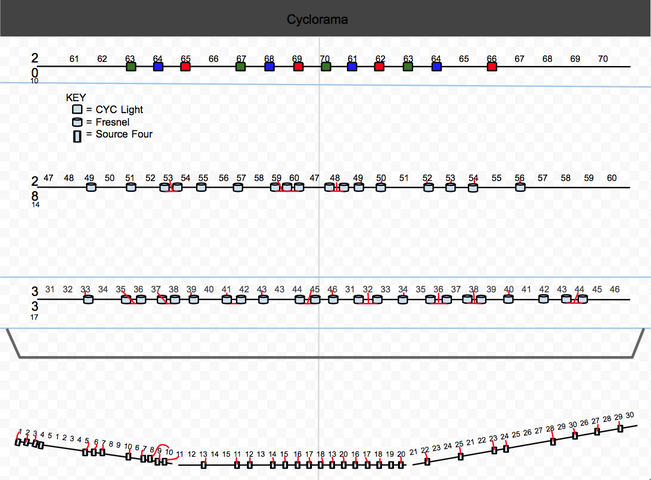CameronLD
Member
Hello CB!
I am a rising junior and the lighting designer for my local high school's theatre program and live shows (think talent competitions). In the past, the most we have done with anything other than white washes and a colored cyc have been a few (like no more than 3) specials per show, whether that be a gobo projected on the cyc, or something like a single pink-gelled light for a romantic scene. However, as the new lighting designer I am trying to make us a more legitimate theatre.
So, what I am thinking of doing next year is installing a warm and cool "base plot" that can be slightly modified for each show to fit the needs of each show. I have attached what I have so far to this post, and was hoping that I could get some critiques/suggestions to fix it and make it even better.
Right now my school pretty much only uses Strand Coolbeams (a discontinued, 575 watt ellipsoidal) in denominations of 19 and 26 degrees for front lighting, and fresnels for top lighting, which are in need of replacement. To solve this I immediately went with the pedigree of the S4, and through my work with Beamwright 5 I think everything should be able to cover its assigned areas. In addition, although my school only uses Rosco gels, through research and talking with an LD I know at Emerson college I chose to go with Lee for the main gels for this plot, and I hope that these colors will blend and work well as front/top lighting. Though this project will take the majority of my budget for each of my next 5 shows, I am convinced it will add immensely to our capabilities, and I hope that those who come after me will then be able to have a strong foundation on which to build upon.
A few questions I had:
- I heard for a McCandless plot (like I hope this one is similar to), you should have your warm and cool lights for each area aimed at 45 degrees opposite of each other. Is this necessary/true and can this be accomplished with a cove that curves such as mine?
- Are my areas too big? I would like to have another one (so they could all be smaller) but I did the math awhile ago and it seemed as if I wouldn't have enough dimmers to add another (especially because my theatre has two outlets for each dimmer, cutting the number of outlets/dimmers we have in half).
- What do you think I can improve?
- What should work and what won't?
Thanks any help you can give!
I am a rising junior and the lighting designer for my local high school's theatre program and live shows (think talent competitions). In the past, the most we have done with anything other than white washes and a colored cyc have been a few (like no more than 3) specials per show, whether that be a gobo projected on the cyc, or something like a single pink-gelled light for a romantic scene. However, as the new lighting designer I am trying to make us a more legitimate theatre.
So, what I am thinking of doing next year is installing a warm and cool "base plot" that can be slightly modified for each show to fit the needs of each show. I have attached what I have so far to this post, and was hoping that I could get some critiques/suggestions to fix it and make it even better.
Right now my school pretty much only uses Strand Coolbeams (a discontinued, 575 watt ellipsoidal) in denominations of 19 and 26 degrees for front lighting, and fresnels for top lighting, which are in need of replacement. To solve this I immediately went with the pedigree of the S4, and through my work with Beamwright 5 I think everything should be able to cover its assigned areas. In addition, although my school only uses Rosco gels, through research and talking with an LD I know at Emerson college I chose to go with Lee for the main gels for this plot, and I hope that these colors will blend and work well as front/top lighting. Though this project will take the majority of my budget for each of my next 5 shows, I am convinced it will add immensely to our capabilities, and I hope that those who come after me will then be able to have a strong foundation on which to build upon.
A few questions I had:
- I heard for a McCandless plot (like I hope this one is similar to), you should have your warm and cool lights for each area aimed at 45 degrees opposite of each other. Is this necessary/true and can this be accomplished with a cove that curves such as mine?
- Are my areas too big? I would like to have another one (so they could all be smaller) but I did the math awhile ago and it seemed as if I wouldn't have enough dimmers to add another (especially because my theatre has two outlets for each dimmer, cutting the number of outlets/dimmers we have in half).
- What do you think I can improve?
- What should work and what won't?
Thanks any help you can give!



